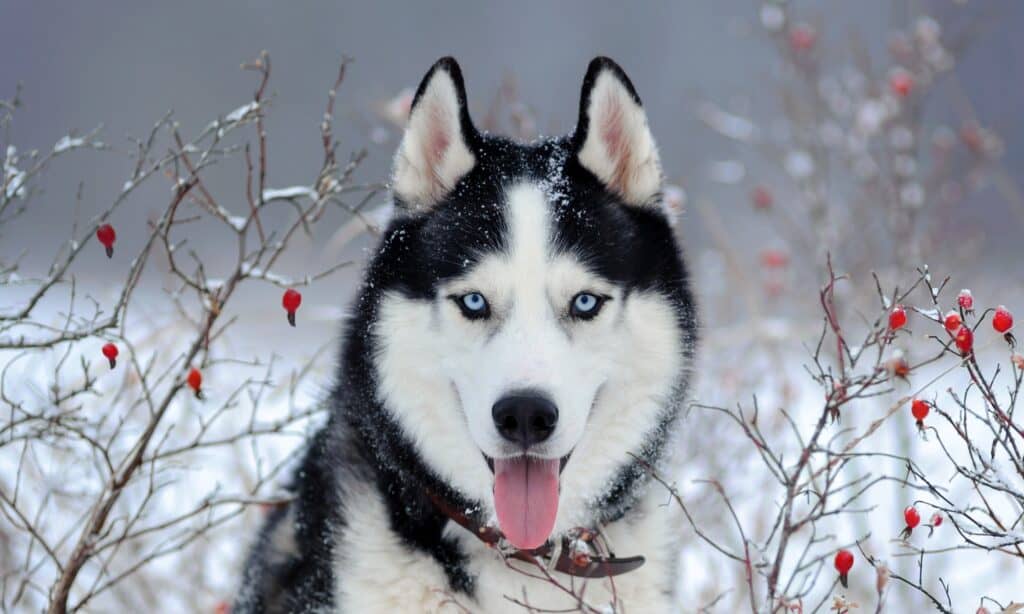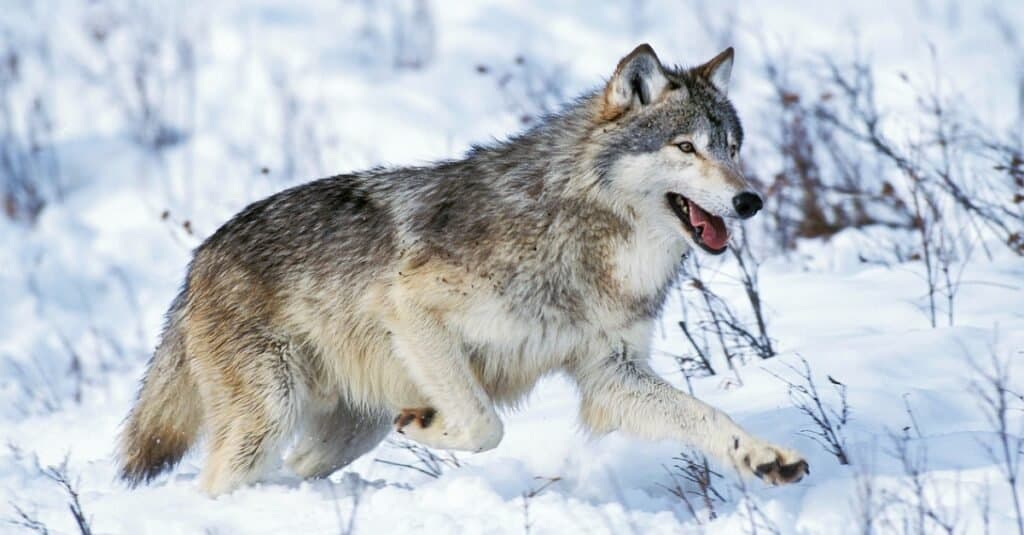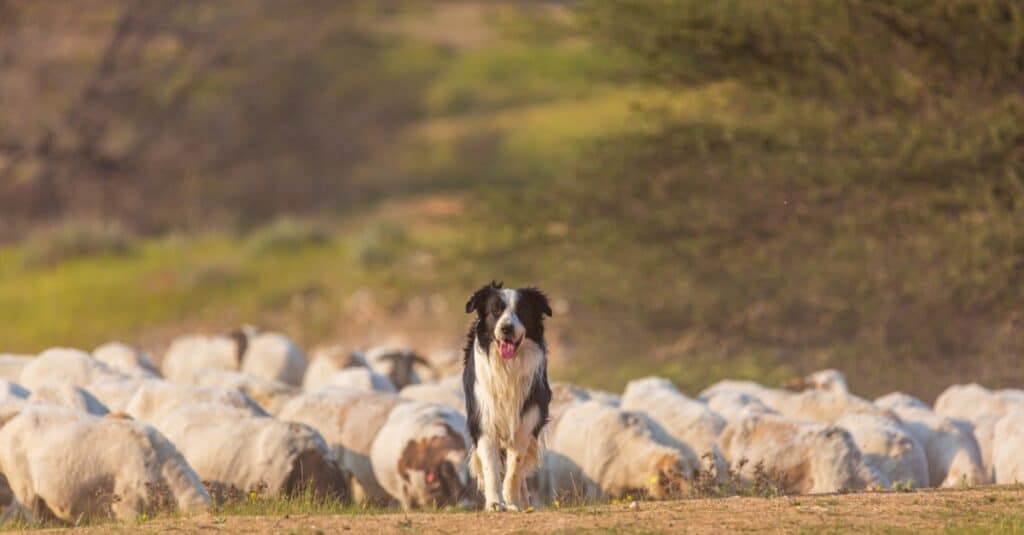Dogs are thought to be among the first animals that humans domesticated. In fact, most researchers suggest that the dog was the very first animal that humans incorporated into daily life. We were walking with Man’s Best Friend even before we were utilizing goats and sheep.
Estimates of the earliest instance of domestication range anywhere from 10,000 to 30,000 years ago. In any case, there’s a long and interesting history connecting ancient wolves and the lackadaisical pooch panting by your side.
Let’s explore humanity’s domestication of dogs, running from the ancient past all the way up to the present.
The Very First Domesticated Dogs

Most people think that dogs are descendents of the grey wolf
©Alan Jeffery/Shutterstock.com
It seems like common knowledge that dogs are descended from wolves. It makes perfect sense, and it’s the conclusion most of us come to if we give it any thought.
In reality, though, dogs aren’t directly descended from wolves as we know them. It’s believed that dogs are actually related to an extinct population that was a predecessor of the modern Grey Wolf. It’s likely that this ancestor was the Late Pleistocene Wolf who would have lived anywhere from 56,000 to 7,500 years ago.
This close cousin of the grey wolf is also called the cave wolf and is thought to have lived in western Europe. It would have been the forebearer of the Canis lupus classification that grey wolves now occupy. Roughly 35,000 years ago, the Late Pleistocene Wolf population split into two dominant categories.
One of those categories was the grey wolf (C. lupus). Grey wolves proliferated and spread across Eurasia and into North America, generating more than 30 subspecies under the C. lupus categorization.
The other category was the domesticated dog (C. lupis familiaris). This split is indicated by genetic studies showing divergence between the two populations around that time. These studies also show that the domesticated dog and wolf are less related to each other than they are their predecessor, suggesting that the lineages move directly from the Late Pleistocene Wolf to the domestic dog and the wolf, respectively.
These predecessors would have been more easily tamed and domesticated than the grey wolf. Even today, a wolf that’s raised in captivity among humans is still considered “wild.” Naturally, we can’t go back in time to examine the demeanor of the Late Pleistocene Wolf, but we can imagine that it would have been more easily tamed than modern grey wolves roaming the northern United States.
But Why Are Dogs & Wolves So Similar?

Siberian husky
– some dogs are almost indistinguishable from wolves
©iStock.com/format35
You might wonder how in the world dogs and wolves are so distant from one another when they look and behave so similarly. In fact, many of our domesticated dogs are almost indistinguishable from wolves.
This is because of something called “gene flow.”
The history of dogs and wolves involves a lot of cross-breeding, leaving genetic material from wolves in the DNA of domesticated dogs and vice versa. There’s likely a lot more wolf DNA in dogs than there is dog DNA in wolf populations, however.
In most cases, two separate species that can produce offspring aren’t able to have viable offspring. That is to say, separate species rarely produce offspring that can produce offspring of their own. Dogs and wolves are among the rare exceptions who are able to produce viable offspring with one another.
C. lupis and C. lupis familiaris are interfertile, meaning they have viable offspring who can then breed with other dogs and wolves, further intermingling the gene pool.
Various Pups May Have Emerged Simultaneously
Fossil evidence from areas across Eurasia indicates that dogs didn’t just come from one population of early wolves. While there’s still a lot to discover, researchers think the domestication process might have happened in multiple places at once.
So, a group of humans in Siberia might have started domesticating wild Pleistocene Wolves around the same time that people in western Europe were doing the same thing. This throws a puzzling wrench in the question of who the modern dog’s earliest ancestors are, though.
Key Evidence of Early Domestication

Some of the earliest domesticated dogs were “wolf-like” animals used for hunting
©iStock.com/slowmotiongli
The earliest transitions from Late Pleistocene Wolf (we’ll just say “wolf” from here on in) to early dogs are difficult for paleontologists to recognize. It’s challenging because the emerging species were very similar, and there would have been a normal range of genetic variation among individuals in both populations.
That means there were dog-like wolves and wolf-like dogs at the same time. Those connections make it difficult to distinguish the fossils of these early pooches.
Those similarities persisted for a long time, too. In the early stages of domestication, people were still moving and hunting in ways that called for wolf-like dogs. Large scavengers with the body and intelligence of wolves would have been useful companions back when we were fighting to live in the prehistoric world.
The Paleolithic Dog (Canis c.f. familiaris)
The Paleolithic Dog was a canine deeply connected to European settlements and camps dating back more than 30,000 years. It’s unknown if this was a domesticated dog, however, which is why its scientific name has “c.f.” before the indication of subspecies.
This means that an expert has proposed the Paleolithic Dog was a member of C. familiaris, although it isn’t verified. These dogs could have been natural variants of Late Pleistocene wolves who enjoyed a symbiotic relationship with humans.
Remains of these animals have been found in multiple dig sites containing human remains or near the possessions of early humans, however. This indicates that Paleolithic Dogs could have been very important to these people.
Further, Paleolithic Dogs were smaller than ancient wolves. One of the key indicators of domestication in dogs is what’s called “neotenization.” This is the gradual shrinking of body parts over generations in response to different environmental factors.
For dogs, the snout and skull would shrink as domestication moved forward. Humans might have selected and bred shorter-snouted dogs to reduce aggression.
Paleolithic dogs have a smaller skull and short snout, so they could have been some of the earliest domesticated dogs.
14,223 Years Ago: The Bonn-Oberkassel Dog
There are many debated fossils that could be the early remains of dogs. Some potential fossils are even older than 30,000 years old. All of these are too contentious and unclear to use as definite waypoints in our map of dog domestication, however.
The Bonn-Oberkassel Dog is widely accepted as the oldest ever fossil evidence of the domesticated dog. The remains were certainly C. lupis familiaris and not those of a wolf.
The bones are dated at 14,223 years old. The dog was morphologically similar to modern dogs, meaning that it would’ve looked more like a proper dog than a wolf. The beautiful thing about these remains, though, is that they indicate a strong emotional bond between the animal and its human owners.
The Bonn-Oberkassel bones were discovered in a grave with the bones of two humans. These included the bones of a middle-aged man and a younger woman alongside the dog’s body. Further, a pathology study shows that it survived canine distemper when it was very young.
A dog with canine distemper would not have survived without significant human intervention. This means that humans cared enough for the animal to go out of their way to treat its illness, utilizing specific knowledge about treating dogs in the process.
Just to give a little perspective, humans 14,223 years ago were living alongside saber-toothed tigers, woolly mammoths, cave bears, and all manner of ancient megafauna. At the same time, we were also tending to the needs of our beloved pooches and caring for them so much that they were laid to rest with us in our graves.
The Divergence of Breeds

The progression of agriculture lead to a need for dogs to carry out essential jobs alongside humans
©iStock.com/Vladimir1965
We might have left Africa around 60,000 years ago and made two separate journeys out to east Asia and western Europe, joining with dogs in those places roughly 30,000 years ago.
15,000 years later, humans cross the Bering Strait and enter North America with dogs in tow. By that time, we’d bred dogs for various utilitarian purposes, leading them to look very distinct from their predecessors. As the Bonn-Oberkassel bones show us, we’d also brought these pups into our hearts.
Then, agriculture emerged in distant corners of the world simultaneously around 11,000 years ago. This did two important things for the dog populations in those areas.
First, it provided hundreds of absolutely essential jobs for dogs to do. Dogs were tasked with protecting crops, monitoring newly domesticated livestock, and serving other culturally-specific roles.
Second, agriculture allowed human beings to become stationary. All of the time spent moving, hunting, gathering, and planning could now be used on other things. More care is given to animals, and new professions emerge that require the assistance of dogs.
All of those factors caused humans to select for different mental and physical qualities in their dogs. Dogs might have been selectively bred to hunt wildlife, eliminate rodents, herd sheep, handle cattle, and more.
There are over 340 dog breeds in the world today, according to the American Kennel Club. That’s the strict number of recognized breeds, although there is an almost infinite number of potential hybrids. All of these wonderful, unique animals can find their roots in the demands of ancient peoples and their animals.
Coevolution
Interestingly, there are hundreds of genes that show correlations between dogs and humans. This makes sense, too, considering that dogs have been alongside human populations for many thousands of years.
As people entered new environments, the adaptive genes in dogs were selected at the same time as the adaptive genes in humans. Over the course of 30,000 years, dogs and humans evolved alongside one another. Those environments selected for mirroring genes in both species.
Interestingly, dogs and humans are aspects of one another’s environments. For example, a dog with cute puppy eyes might be selected because of how it makes the human feel, and a human who works well with dogs might have a more successful farm, giving him a better chance of survival than someone who’s bad with dogs.
Epigenetic Changes

Domestication syndrome lead to the development of dogs with different characteristics
©Martin Christopher Parker/Shutterstock.com
Domesticated animals experience something called “domestication syndrome.” Generally speaking, the syndrome leads to droopier ears, changes in coloration, reduction in brain size, and a general reduction in size.
This change is a large aspect of the domestication of dogs. The rapid changes in dog characteristics during domestication might be linked to epigenetic shifts. Epigenetic modifications are heritable changes in behavior that aren’t reflected in the individual’s DNA.
Alongside environmental changes, these heritable modifications in dog behavior might have contributed to the rapid proliferation of different breeds over time.
The process of epigenetic changes is thought to come from the activation or deactivation of certain genes as a result of interactions with the environment. Those factors impact physiology and neurology, producing distinct shifts in behavior. Those behavioral changes are learned by subsequent generations, and the new traits start to solidify over time.
Apply that epigenetic pressure to thousands of dogs in different environments, and the tree of life starts to spread its little branches, leaving us with all of the wonderful pooches that we know and love so much!
Want to Learn More About Dogs?
- I Finally Found Out Why Dogs Smell Butts So Much
- What Were French Bulldogs Bred For? Original Use, History, and Jobs
- If There Are Big Cats, Why Are There No Big Dogs?
- How Fast Can Dogs Run, And Which Is Quickest?
The photo featured at the top of this post is © Martin Christopher Parker/Shutterstock.com
Ready to discover the top 10 cutest dog breeds in the entire world?
How about the fastest dogs, the largest dogs and those that are -- quite frankly -- just the kindest dogs on the planet? Each day, AZ Animals sends out lists just like this to our thousands of email subscribers. And the best part? It's FREE. Join today by entering your email below.
Thank you for reading! Have some feedback for us? Contact the AZ Animals editorial team.






